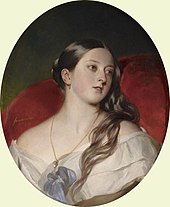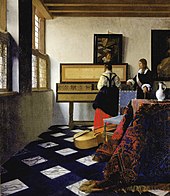Royal Collection
The Royal Collection is the art collection of the British royal family . It is owned by the British monarch , but is not part of his private assets, but is held in trust (Royal Collection Trust) . The collection includes over 7,000 paintings , 40,000 watercolors and drawings and 150,000 art prints , but also tapestries, furniture, ceramics, books and other works of art. The collection is estimated to be worth over £ 10 billion .
The collection is spread over several locations. Some, such as Hampton Court Palace , are open to the public and are not inhabited by the royal family. Others like Windsor Castle have restricted access due to their function as residences. Changing exhibitions are shown in the Queen's Gallery at Buckingham Palace in London . There is another Queen's Gallery at Holyrood Palace in Edinburgh .
history

Few objects exist from before the reign of King Henry VIII . Charles I put together the basis for the collection , in particular by purchasing the collection of the Gonzaga family from Mantua . It contained works by Raffael , Leonardo da Vinci , Domenico Tintoretto , Tizian , Antonio da Correggio , Annibale Carracci , Guido Reni , Andrea Mantegna and Orazio Gentileschi . Other works were added through donations, for example by Albrecht Dürer . Charles I was an avid art collector and also promoted contemporary artists, above all Peter Paul Rubens and Anthonis van Dyck . After Charles' execution in 1649, most of the collection was sold during the Republican phase of the Commonwealth of England .
During the Stuart restoration , some works of art were recovered. For example, in 1660 King Charles II received a generous donation, called the Dutch Gift , from the Dutch Republic , consisting of 28 paintings from the Italian Renaissance and twelve classical sculptures. Charles II followed his father's example and was also an art collector. Towards the end of the 17th century, when numerous Huguenot artists came to England, the proportion of works of art with French characteristics increased significantly. Queen Mary II began building a china collection while her consort William III. Showed interest in technical devices such as clocks and barometers.

Caroline von Brandenburg-Ansbach , the wife of George II , collected works of art from the 16th century. Her son Friedrich Ludwig von Hanover mainly acquired paintings by French and Flemish artists such as Gaspard Poussin , Eustache Le Sueur , Jan Brueghel and Frans Hals . He promoted contemporary Rococo artists , including Jacopo Amigoni and Charles André van Loo .
George III acquired the collection of Joseph Smith , the British consul in Venice , in 1762 , which brought numerous works by Venetian artists to the Royal Collection. These included Canaletto , Sebastiano Ricci , Marco Ricci , Rosalba Carriera and Giovanni Battista Piazzetta . George III but was mainly interested in valuable books and manuscripts. He endeavored to fill in the gaps his father had created by donating the Royal Library to the British Museum in 1757 . When promoting the arts, he focused on British artists such as Allan Ramsay , Johann Zoffany , Thomas Gainsborough , John Hoppner , John Singleton Copley , William Beechey and Benjamin West .
A particularly avid collector proved to be George IV , who was interested in paintings, jewels, furniture, porcelain, sculptures, interior design and weapons. This markedly increased the scope of the Royal Collection. He mainly acquired Dutch and Flemish paintings, among others by Gerard ter Borch and Aelbert Jacobsz. Cuyp , Gerard Dou , Nicolaes Pietersz. Berchem , Philips Wouwerman , Adriaen van Ostade , Rembrandt and Rubens. George's work as a promoter of contemporary art remains unmatched, which is why his reign gave its name to the Regency art epoch . His favorite painters included George Stubbs , Benjamin Marshall , David Wilkie, and Thomas Lawrence .


William IV limited himself largely to china and books. Victoria had much broader interests , especially during her marriage to Albert von Sachsen-Coburg and Gotha . In painting, she preferred contemporary works by Edwin Landseer , Stanley William Hayter , William Frith , Franz Xaver Winterhalter and David Roberts . In addition, she acquired numerous early Italian masters such as Fra Angelico , Benozzo Gozzoli and Duccio di Buoninsegna . The couple showed great interest in contemporary sculpture, including by John Gibson , William Theed , Emil Wolff , Carl Steinhäuser , Julius Troschel , József Engel , Joseph Boehm and Mary Thornycroft . Many of the art objects that were collected and received as gifts formed the basis for the Victoria and Albert Museum .
With Edward VII , who was married to Alexandra of Denmark , more Danish works of art found their way into the Royal Collection. He also built up a significant collection of handicrafts from the workshop of Peter Carl Fabergé , including three Fabergé eggs . The most important of the numerous gifts is the Cullinan diamond , the largest rough diamond ever found. George V and his wife Maria von Teck expanded the Fabergé collection. In addition, they were particularly interested in handicrafts and precious books. George VI. and Elizabeth Bowes-Lyon focused on contemporary painters such as Claude Monet ( Le Bloc ), Paul Nash, and John Everett Millais .
The reign of Elizabeth II was marked by great progress in curatorial and journalistic activities, renovations and the organization of exhibitions. Acquisitions primarily serve to complete existing collections, whereby the historical element stands out clearly from the contemporary.
administration
The Royal Collection Department , a registered charity and one of five departments of the Royal Household , is responsible for the administration of the Royal Collection. This includes cataloging, preserving, cleaning, restoring and exhibiting works of art gathered by members of the royal family. The maintenance of buildings is not part of the area of responsibility. In fiscal 2011/12, the Royal Collection Department employed 447 full-time employees and had sales of £ 50.3 million.
Web links
Individual evidence
- ↑ Administration. Royal Collection, accessed October 6, 2012 .
- ^ The Royal Collection Department. British Royalty, accessed June 14, 2010 .
- ↑ The Queen. The Times , April 27, 2008, accessed June 14, 2010 .
- ↑ a b c d e f g h History of the Royal Collection: The Collectors. Royal Collection, archived from the original on January 7, 2011 ; accessed on June 14, 2010 (English).
- ^ Fabergé from the Royal Collection . Exhibition catalog, Queen's Gallery, Buckingham Palace, London 1985.
- ↑ Annual report 2011/12. (PDF; 6.5 MB) (No longer available online.) Royal Collection Trust, 2012, archived from the original on October 25, 2012 ; accessed on October 6, 2012 (English). Info: The archive link was inserted automatically and has not yet been checked. Please check the original and archive link according to the instructions and then remove this notice.


